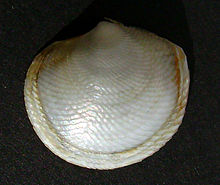Lucinoidea
| Lucinidae Temporal range: Silurian - recent |
|
|---|---|
 |
|
| Divaricella huttoniana | |
| Scientific classification | |
| Kingdom: | Animalia |
| Phylum: | Mollusca |
| Class: | Bivalvia |
| Subclass: | Heterodonta |
| Order: | Veneroida |
| Superfamily: | Lucinoidea |
| Family: |
Lucinidae Fleming, 1828 |
| Genera | |
|
See text |
|
See text
Lucinidae is a family of saltwater clams, marine bivalve molluscs.
These bivalves are remarkable for their endosymbiosis with sulphide-oxidizing bacteria.
The members of this family are found in muddy sand or gravel at or below low tide mark. They have characteristically rounded shells with forward-facing projections. The valves are flattened and etched with concentric rings. Each valve bears two cardinal and two plate-like lateral teeth. These molluscs do not have siphons but the extremely long foot makes a channel which is then lined with slime and serves for the intake and expulsion of water.
Lucinids host their sulfur-oxidizing symbionts in specialized gill cells called bacteriocytes. Lucinids are burrowing bivalves that live in environments with sulfide-rich sediments. The bivalve will pump sulfide-rich water over its gills from the inhalant siphon in order to provide symbionts with sulfur and oxygen. The endosymbionts then use these substrates to fix carbon into organic compounds, which are then transferred to the host as nutrients. During periods of starvation, lucinids may harvest and digest their symbionts as food.
Symbionts are acquired via phagocytosis of bacteria by bacterioctyes. Symbiont transmission occurs horizontally, where juvenile lucinids are aposymbiotic and acquire their symbionts from the environment in each generation. Lucinids maintain their symbiont population by reacquiring sulfur-oxidizing bacteria throughout their lifetime. Although process of symbiont acquisition is not entirely characterized, it likely involves the use of the binding protein, codakine, isolated from the lucinid bivalve, Codaki orbicularis. It is also known that symbionts do not replicate within bacteriocytes because of inhibition by the host. However, this mechanism is not well understood.
Lucinid bivalves originated in the Silurian; however, they did not diversify until the late Cretaceous, along with the evolution of seagrass meadows and mangrove swamps. Lucinids were able to colonize these sulfide rich sediments because they already maintained a population of sulfide-oxidizing symbionts. In modern environments, seagrass, lucinid bivalves, and the sulfur-oxidizing symbionts constitute a three-way symbiosis. Because of the lack of oxygen in coastal marine sediments, dense seagrass meadows produce sulfide-rich sediments by trapping organic matter that is later decomposed by sulfate-reducing bacteria. The lucinid-symbiont holobiont removes toxic sulfide from the sediment, and the seagrass roots provide oxygen to the bivalve-symbiont system.
...
Wikipedia
